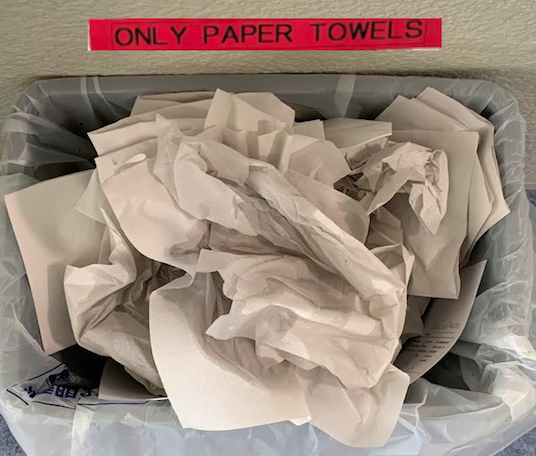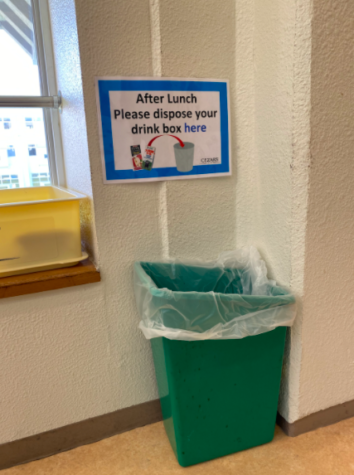
Only paper towels can be disposed of in classroom trash cans. (Image by June Y.)
The double-edged sword: Are we really disposing of less trash?
Most of us dispose of our waste without a second thought. COVID-19, however, has made it necessary to consider how best to dispose of their waste in order to avoid transmission. This trend is particularly conspicuous in the Sacred Heart community, where new regulations strictly restrict the types of materials that can be disposed of in school wastebaskets. We predicted that these new regulations would positively impact our community’s waste disposal.
To test our hypothesis, the Environmental Science class sent out a survey to our high school student body to collect data, asking how the type and amount of waste they produce compare to years before the pandemic.
Out of the 41 responses we received, 59% responded that their most common waste product in the previous school year had been plastic. This school year, however, Sacred Heart prohibited all members of the school community from disposing of anything apart from paper towels used to disinfect and dry hands for precautionary measures. Because of this, our main waste product, plastic, has been substantially reduced.
The majority of the students also further commented that the new restriction has led them to buy less food in the cafeteria and fewer beverages from vending machines. Instead, students were more prone to eat homemade lunch boxes that alternatively produced less trash.

However, some students responded that the pandemic has led them to dispose of more trash in general because of the disposal of masks and paper towels. The survey, however, could not conclude whether our community is now producing more or less waste in general. It, therefore, seems that the pandemic is a double-edged sword from an environmental perspective — while we produce less plastic waste, we produce waste in the forms of paper and disposable masks.
The promising news, however, is that these materials—paper towels, fabric, and paper—are significantly easier to combust efficiently than plastics and are less damaging to the environment.
For instance, according to MIT Engineering, plastics require tremendous energy to combust and when subjected to flame, release toxic chemicals, such as hydrochloric acid, sulfur dioxide, dioxins, furans, heavy metals, and particulates. These toxicants contribute to human respiratory ailments, irritate the immune systems, and pose a potential threat as a carcinogenic.
On the other hand, fabric and paper are relatively easier and safer to combust. Although the specific temperature range varies depending on multiple variables, fabrics and papers can be combusted at a notably lower temperature range than plastic.
Therefore, regardless of the possible increase in the amount of waste disposal, our waste’s environmental impact has decreased significantly throughout the pandemic.